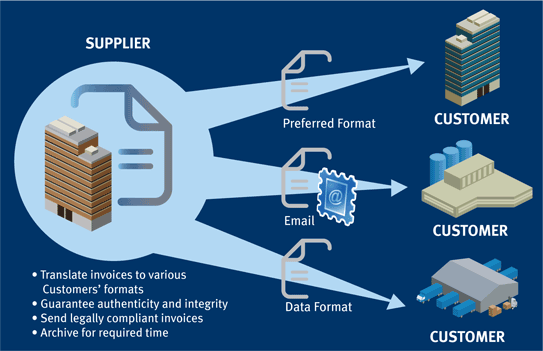The difference between eInvoicing and eBilling
The electronic invoicing process is sometimes referred to as eInvoicing and sometimes as eBilling, causing occasional confusion. In general, this use of different terms arises from whether your perspective is that of a buying or a selling organisation.
From the buying company’s perspective, managing incoming invoices within the accounts payable department, the electronic invoicing process is part of what is known as the Order-to-Pay process and is called “e-invoicing.” From the selling company’s perspective, which is sending bills out to customers via the accounts receivable department, the electronic invoicing process is part of the Order-to-Cash process and is called “e-billing.” In both cases invoices are processed, but the different perspective changes the name of the process to either B2B e-Invoicing or B2B e-Billing.
Perhaps the easiest way to think about the difference between the two is that if the invoice is ‘inbound’ it is an e-Invoice and if it is ‘outbound’ it is an e-Bill. The diagram below illustrates the selling company perspective, eBilling.

eBilling adoption has been a little slower than the adoption of eInvoicing to date. But, in terms of volumes, eBilling suppliers broadcast thousands of eBills at a time, so it is not a volume-related challenge. According to Billentis, there were 1,045 million eBills issued in Europe, compared with 1,275 million eInvoices.
It is commonly believed that the eInvoicing and eBilling models will converge over time because both suppliers and buyers want to exchange electronic invoices. But, large corporate buyers only want to receive invoices as data files that can be automatically uploaded into their accounting systems, rather than receiving PDF invoices, for example. This may be one reason why eBilling adoption has been somewhat slower to date.
As this website focuses on B2B environments the use of the term e-Billing within the site should not be confused with consumer billing, which is not covered.
There are other terms that you will come across in eInvoicing and eBilling, such as EBPP and EIPP. You can read more about them in the Glossary.
Making an impact
New electronic invoicing models automate both buyer and seller, simplifying the end-to-end invoicing processes for customers and trading partners alike. It is technologies such as eInvoicing, eBilling and EIPP and EBPP that provide the platform to remove paper and capture the cost savings that will directly impact your company’s bottom-line.
Need any help?
One of our eInvoicing experts would be happy to answer any questions you have. Simply ask an eInvoicing expert »
